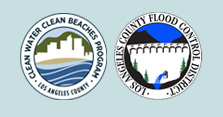Ordinance Framework
Ordinance Framework
Under the LA County Clean Water, Clean Beaches Program, a Clean Water Fee, would be collected annually.The LA County Board of Supervisors would have ultimate responsibility to oversee the Program.
Expenditure of funds would be guided by the following documents:
- An Ordinance developed and adopted by the LA County Board of Supervisors pursuant to Proposition 218 and AB 2554, describing how Clean Water Fee would be collected and expended (updated 1/29/13)
- An Implementation Manual outlining details of the Clean Water, Clean Beaches Program. Recently developed Project Selection Criteria will be incorporated into the Implementation Manual as well. (updated 1/29/13)
- Water Quality Improvement Plans (WQIPs) developed by Watershed Area Groups (WAGs) for each of the nine Watershed Areas established by AB 2554.
- Plans and budgets of the Flood Control District (FCD) and Municipalities, consistent with the Ordinance and Implementation Manual.
Public comments on the updated draft program documents are encouraged and appreciated. Please email comments to: [email protected] by Friday, February 15, 2013.
The process for funding and determining projects is shown in the Overview Framework and described below.
Flood Control District (10%)
FCD would retain 10% of the funds for regional efforts such as water quality monitoring, regional projects, research and development, outreach and education, studies and computer modeling, as well as program oversight and auditing, and administering the fee.
The remaining 90% of the funds would be returned to the local communities from which it was raised through two programs – 1) Municipalities and 2) Watershed Authority Groups as outlined below.
Municipalities (40%)
Forty percent of the funds collected would be disbursed to Municipalities (cities and unincorporated areas of the county), proportionate to the amount of fees paid by property owners in that Municipality. The Municipality would enter into a Transfer Agreement with LA County Flood Control District outlining how funds could be expended and would and would specify that all funds must be spent in accordance with an Ordinance adopted by the Board of Supervisors and the Implementation Manual.
Municipal programs would include at a minimum:
- An Incentive Program for property owners to implement BMPs
- An annual list of projects and programs funded with Fee revenue
Other requirements:
- Municipal projects projected to cost more than $2 million shall be reviewed by the Flood Control District and Oversight Board. Municipalities are encouraged to develop Local Master Plans that include a list of pollutants, targets for reducing pollutant loads, and project locations that can be incorporated into regional Watershed Quality Improvement Plans (see below). Municipalities are also encouraged to follow Program goals as outlined in the Ordinance and Implementation Manual including inclusion of multiple benefits, coordination with other water quality and water resources planning efforts, leveraging other funding sources, etc.
- Municipal expenditures must be annually certified by their governing boards with an accompanying annual audit to ensure fee revenues were used in accordance with provisions in the Ordinance, Implementation Manual, and other documents as appropriate. FCD would perform a secondary audit no fewer less than once every five years.
Watershed Authority Groups (50%)
Fifty percent of the funds collected would be disbursed to WAGs, proportionate to the amount of fees paid by property owners within that Watershed Area. Each WAG would enter into a Transfer Agreement with FCD outlining how funds could be expended and would specify that all funds must be spent in accordance with the Ordinance and Implementation Manual adopted by the Board of Supervisors.
Each WAG would be required to:
- Utilize computer modeling and other studies to identify pollutants in the watershed, establish targets and priorities for meeting water quality standards, and identify locations for placement of projects.
- Develop a Water Quality Improvement Plan (WQIP) to meet established water quality targets
- Establish a Stakeholder Advisory Panel to provide input into development of the WQIP, act as liaison to the local stakeholder community, and make recommendations for projects and programs to be included in the WQIP.
- Annually certify their use of fee revenue met the terms of Ordinance, Implementation Manual, and other documents as appropriate and be accompanied by an annual audit. FCD would perform a secondary audit no fewer less than once every five years.
- Develop a WQIP. The WQIP would be updated every three years.
Each WQIP would include, at a minimum:
- Inventory of pollutants within the watershed
- Targets for meeting water quality standards
- Project locations
- “Activity List” to implement the WQIP including:
1. Incentive Program for property owners to implement BMPs
2. School Program
3. Public Education and Other Programs for that broadly support the goals and objectives of the WQIP
4. Studies and Plan Updates
5. Required operations and maintenance plans for projects of WAG-funded facilities
- Projects:
- Projects and programs would be developed directly by the WAGs or may be developed by third parties and recommended to the WAGs through a call for projects.
- The WAG would empanel a Project Selection Scoring Committee to apply the Project and Program Selection Criteria, consisting of: one member from the Stakeholder Advisory Panel, the WAG representative to the Oversight Committee, two members of the WAG Board, and one member from the Flood Control District.
- Projects and programs would be scored and ranked to determine funding priorities using the Project and Program Selection Criteria specified in the Ordinance and Implementation Manual.
- Each WAG-adopted WQIP would be reviewed by the FCD and the Oversight Board, and would ultimately be certified by the Board of Supervisors
- Once the WQIP is certified by the Board of Supervisors, the WAG would be able to disburse funding for the highest ranked projects and programs for a 5-year planning horizon using the score/rank determined by the Scoring Committee using the Project and Program Selection Criteria.


